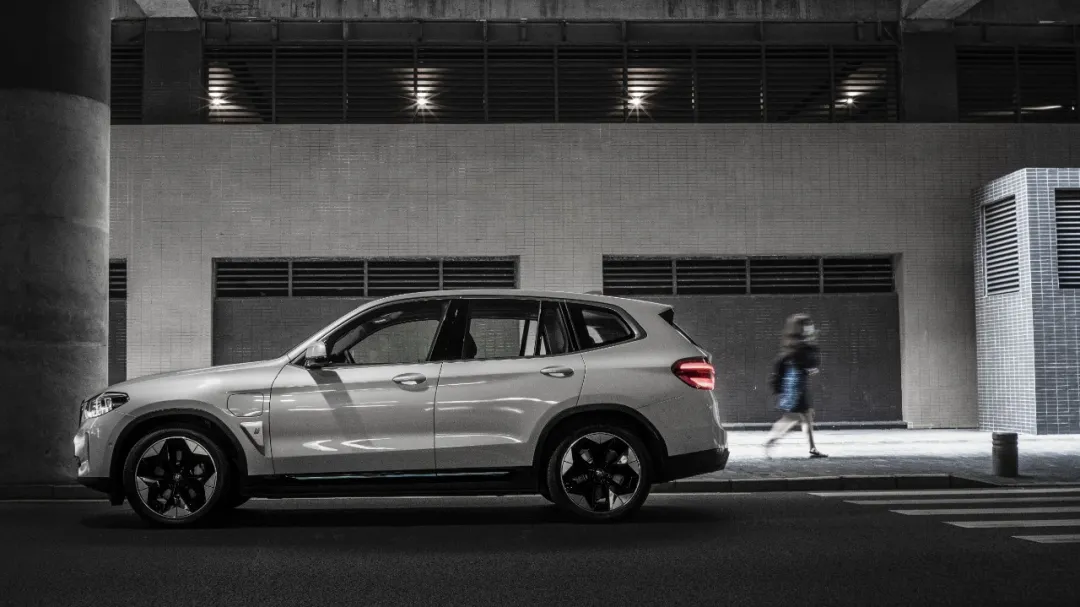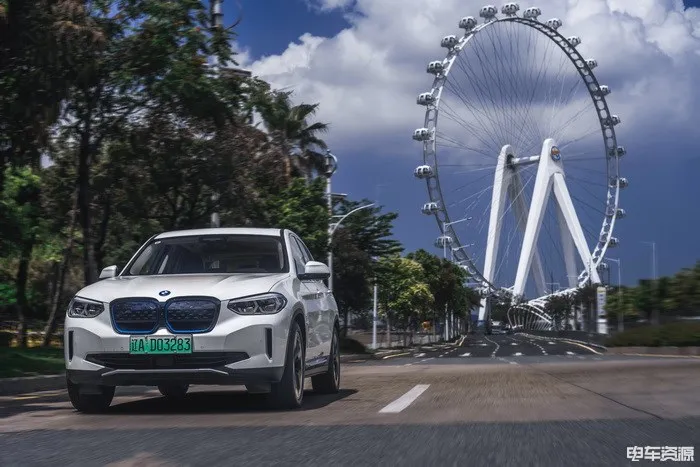Author: Da Shi

The three traditional luxury car brands, BBA, have all completed localization of their three new energy vehicles, the Mercedes-Benz EQC, BMW iX3, and Audi e-tron, which all have a common feature – they are built on existing non-pure electric platforms.
One could argue that, compared to new power brands and some domestic car brands, their transformation in the era of new energy is not as fast. However, if it is said that their progress in the era of new energy is too slow because of this, BMW will definitely be the first to object.
Not Slow, But Too Advanced
In fact, as early as 2011, BMW established a new energy sub-brand “BMW i” and, just two years later, released the mass-produced i3 and i8, which stunned the world with their car body architecture constructed from scratch, the use of various new materials, and avant-garde styling.

Taking the BMW i3 as an example, in order to minimize the weight, the entire frame of the car was constructed using carbon fiber reinforced plastic (CFRP) at any cost. The resulting ultra-high strength can even meet the rigorous safety collision test without the need for a B-pillar.
Therefore, on this small car with a length just over 4 meters, we see unprecedented suicide doors, which not only maintain graceful entry and exit, but also offer decent passenger space.

Is it innovative enough? Is it advanced enough?
In an era where there were no subsidies or policy pressures, it took great courage to build such groundbreaking products from scratch. This was not only a test of market acceptance, but also a huge gamble.The outcome is clear: the target audience and cost of new models cannot be balanced, ultimately leading to the fate of delisting. However, even today, the design concepts of these two models are still quite advanced.
Nowadays, the new energy market has entered a brand-new stage of competition. Driven by policies and capital, the industry is accelerating its transformation towards pure electrification. Stimulated by new products and technologies, consumers’ perception and demand for electric vehicles have undergone great changes.
Faced with the new market environment, BMW has formulated a brand-new electrification strategy, and the BMW iX3 is the first product to land under this new strategy. After the BMW i3, it is the second pure electric vehicle officially launched by the BMW brand. It erases the “experimental” color of the former and presents a different style in a more rational and accurate manner.
However, as a new energy vehicle based on the CLAR platform, the BMW iX3, which is built in the same way as the fuel version X3 and shares a similar appearance, has been labelled with the slightly derogatory tag of “oil-to-electric.”
To discuss this issue, first, we need to be clear about where we diss “oil-to-electric.”
We are just dissatisfied with some automakers’ simple and crude practice of replacing engines with motors and batteries during the initial development stage of new energy vehicles, regardless of the reduction in interior space and deterioration in driving experience. It is the result of not considering multi-power platform at the beginning of design and forcing modification.
However, the same problem did not occur with the BMW iX3.
The fifth-generation eDrive electric drive system integrates the motor, inverter, and transmission, achieving miniaturization. Even if it is arranged on the rear axle, it does not encroach on the cargo space.
The 80 kWh ternary lithium battery developed in cooperation with CATL is arranged on the chassis, extending outward, reducing the minimum ground clearance to 179 mm (216 mm for the fuel version) without encroaching on the passenger cabin’s space.Switching from an iX3 to a regular gasoline-powered X3, aside from the powertrain, you won’t feel any difference in the car’s interior. It’s worth noting that with traditional “gas to electric” vehicle conversions, interior space is always compromised. This includes floor height increase, reduced headroom, more cramped rear seating posture, and so on.
Thanks to the CLAR platform’s future-proofing, it can support the development of pure gasoline-powered, plug-in hybrid, and pure electric vehicle models. The iX3 and X3, both developed on the same platform, are two native vehicle models produced in conjunction, and there is no concept of one “converting” to the other.
For ordinary consumers, the experience matters more than the platform. Excellent power systems, uncompromised space, and up-to-date intelligent devices are the most crucial user experiences.
The BMW iX3 uses the first-ever commercially available excited synchronous motor in an electric car, which offers two advantages over a permanent magnet synchronous motor.
Firstly, excited motors do not use rare earth elements, reducing reliance on scarce resources and cutting costs. Secondly, excited synchronous motors can release their maximum power earlier and increase power output by continuously adjusting the excitation current up to the redline speed when in Sports Mode. In Comfort and Eco modes, the excitation current is reduced to increase powertrain efficiency, and the motor’s excitation current can be switched off entirely, resulting in efficient gliding.
This motor produces a maximum output power of 210 kW (286 hp) and a maximum torque of 400 N·m. Its acceleration time from 0-100 km/h is consistent with the xDrive 30i high-power gasoline version of the X3 at 6.8 seconds.
Although it cannot compare with the 3-4 second acceleration times of dual-motor vehicles, BMW knows exactly what consumers need. Improving the acceleration capability of an electric car is straightforward, but what’s challenging is matching and tuning the throttle, regenerative braking, and brakes, which is where the iX3 excels.The throttle response of the iX3 is very delicate, and in the Eco or Comfort mode, the front end of the throttle is not very sensitive, giving an overall feeling like that of a stable large displacement naturally aspirated engine, with sufficient power reserves. However, if you want to unleash its full potential, you need to press the pedal harder.

Due to the characteristics of the electric motor, the iX3’s acceleration performance, especially at low speeds (0-60 km/h), surpasses the high-power 30i petrol version. As a model primarily used in urban areas, the performance is definitely considered surplus.
BMW won’t mess up a car model with a “3” in its name. From the 3 Series to the X3, they still have the essence of a car that is very drivable and easy to handle. This also allows the iX3 to have extremely high standards in terms of steering precision, suspension damping and responsiveness, and it continues all the strengths of BMW’s driving experience.

In terms of energy regeneration, the iX3 has four modes: low, medium, high, and adaptive. The first three modes are progressively arranged. In the “low” mode, there is basically no drag when you release the throttle, which simulates coasting with a gear like a petrol car and is more friendly to users accustomed to traditional cars.
The adaptive mode, on the other hand, will automatically adjust according to factors such as current speed, road slope, and distance from the vehicle in front of you. Regenerative braking will generate different deceleration depending on different road conditions, and it needs some time to adapt.

If you are accustomed to the unique “single-pedal mode” of an electric car, just shift the electronic gear lever to B and use the Auto Hold function. This can significantly alleviate ankle fatigue in certain specific scenarios such as traffic congestion.
The iX3 uses CATL’s NCM811 battery cells and the module and battery pack were developed by BMW themselves. In order to ensure safety, BMW has adopted a large number of passive and active safety designs on the battery pack, controlling the energy density of the battery pack to only 154 wh/kg, while other energy densities commonly used in NCM811 cells exceed 180 wh/kg.

And to ensure the lifespan of the battery pack, there is also a redundant power capacity of 6 kWh (encapsulating 80 kWh with 74 kWh available). This guarantees stability in battery energy storage during full charge and discharge cycles, and ensures that the battery’s power degradation is less than 20% over a driving distance of 1 million kilometers.

In actual driving scenarios, the iX3 dashboard accurately reflects the remaining range, and the estimated remaining range is nearly 1:1 with the actual driving range. Thanks to the battery pack’s 8% reserve capacity, the current drawn from the DC fast charger remains high until the battery is about 95% charged, then the charging power gradually decreases from 80 kW to enter trickle charge mode.
Smart solutions are equally impressive
From platform architecture to electric drive systems, from performance parameters to actual performance, the BMW iX3 is well-balanced and impressive. However, the era of “software-defined cars” demands smart cabins and intelligent driving technologies as core competitive points.

Currently, the BMW iX3 is equipped with the familiar iDrive 7.0 intelligent interaction system, which supports touch input, rotary knobs, and even some hand gesture operations. This system has been optimized specifically for Chinese users, integrating third-party applications such as QQ Music, Himalaya, and Xigua Video in addition to wireless Apple Carplay and Baidu Carlife functionality.

Furthermore, the iX3 features intelligent voice recognition, automated driving assistance system Pro, and full-car FOTA updates as standard equipment.
Particularly notable is the automated driving assistance system Pro, which leverages the Mobileye EyeQ4 chip and integrates one forward-looking triple-lens camera, four panoramic cameras, one full-distance millimeter-wave radar, four short-range millimeter-wave radars, and twelve ultrasonic sensors to achieve L2+ level driving assist.
 The specific features include: adaptive cruise control with full-speed range, lane keeping, traffic jam assist, lane change assist with turn signal, etc. It can also achieve functions such as automatic parking and 50-meter reverse assist. Although it doesn’t have the more powerful navigation assist found in new forces in the industry, the traffic jam assist function is still very practical.
The specific features include: adaptive cruise control with full-speed range, lane keeping, traffic jam assist, lane change assist with turn signal, etc. It can also achieve functions such as automatic parking and 50-meter reverse assist. Although it doesn’t have the more powerful navigation assist found in new forces in the industry, the traffic jam assist function is still very practical.

When driving at a speed below 60 km/h with clear lane markings, the system can be activated, and green indicator lights will appear at 3 and 9 o’clock on the steering wheel. At this time, the user can completely release their hands, just need to keep their eyes on the road ahead and be recognized by the camera on the instrument panel. It can automatically follow the car ahead in the lane for a long time without the need for manual control. This feature is especially enjoyable in traffic jams on the highway.

BMW’s active driving assistant system not only has comprehensive features, but also is stable and reliable in operation, providing a very good user experience. It’s no wonder that this system achieved a “VERY GOOD” rating in the E-NCAP 2020 driving assist test.
Conclusion
Although the BMW iX3 is a well-balanced pure electric SUV with many advantages and no obvious shortcomings, such as endurance, power, handling, comfort, and more, it does have some limitations. Due to platform restrictions, its appearance cannot be significantly distinguished from gasoline-powered models, and it is difficult to make a breakthrough in terms of “technological sense” and “future sense.”
However, at a starting price of less than 400,000 yuan, the BMW iX3 still has plenty of reasons that are hard to refuse. Let’s leave the “future” to the forthcoming iX.
This article is a translation by ChatGPT of a Chinese report from 42HOW. If you have any questions about it, please email bd@42how.com.